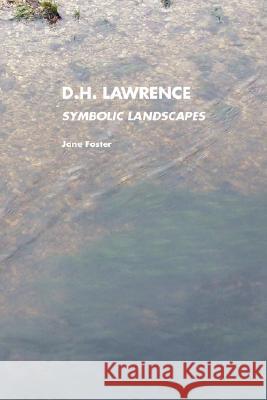D.H.Lawrence: Symbolic Landscapes » książka
D.H.Lawrence: Symbolic Landscapes
ISBN-13: 9781861711472 / Angielski / Miękka / 2008 / 140 str.
D.H. LAWRENCE: SYMBOLIC LANDSCAPES This book analyzes the rich discourses of mythology, symbolism, form, eroticism and landscape in D.H.Lawrence's fiction. Jane Foster traces Lawrence's symbols (tigers, suns, fish, peacocks) in many of the short stories, as well as the major novels. 'Spirit of place' was always important for Lawrence, and Foster's study investigates how Lawrence's concept of place informed his fiction, poetry and travel books. EXTRACT Lawrence uses many traditional poetic symbols - flowers, fire, the Moon - but there are some symbols that he has made very much his own: blood, rivers, the phallus, rainbow and the Lawrencean bestiary: horse, phoenix, peacock, dragon, snake, lion, tiger, rabbit and fish. The Lawrencean animals are the most alive of living symbols. There are many symbolic beasts in the poems too: fish, tortoises, snakes, eagles, elephants, mosquitoes, goats, etc. ----- D.H. Lawrence probably uses more flowers in his art than any other comparable writer. The poems are full of flowers - irises, violets, roses, campions - all kinds of flowers, hundreds of flowers, blossoms and plants. He fills his books with flowers rather like the Early Netherlandish painters filled their paintings of the Madonna with heaps of flowers. Lawrence uses flower symbolism to underpin the action and the emotional states of his characters. Ursula, for instance, delights, as Connie Chatterley does, in flowers. They remind her of the beauty of the world when the pain of love becomes too much. In Women in Love, Ursula is transported, to use the old term, by some daisies floating in water: She went along the bank towards the sluice. The daisies were scattered broadcast on the pond, tiny radiant things, like an exaltation, points of exaltation here and there. Why did they move so strongly and mystically? "Look," he said, "your boat of purple paper is escorting them, and they are a convoy of rafts. Some of the daisies came slowly towards her, hesitating, making a shy, bright little cotillion on the dark clear water. Their gay, bright candour moved her so much as they came near, that she was almost in tears. "Why are they so lovely?" she cried. "Why do I think them so lovely?" With illustrations, bibliography and notes.
D.H. LAWRENCE: SYMBOLIC LANDSCAPES
This book analyzes the rich discourses of mythology, symbolism, form, eroticism and landscape in D.H.Lawrences fiction. Jane Foster traces Lawrences symbols (tigers, suns, fish, peacocks) in many of the short stories, as well as the major novels. Spirit of place was always important for Lawrence, and Fosters study investigates how Lawrences concept of place informed his fiction, poetry and travel books.
EXTRACT
Lawrence uses many traditional poetic symbols - flowers, fire, the Moon - but there are some symbols that he has made very much his own: blood, rivers, the phallus, rainbow and the Lawrencean bestiary: horse, phoenix, peacock, dragon, snake, lion, tiger, rabbit and fish. The Lawrencean animals are the most alive of living symbols. There are many symbolic beasts in the poems too: fish, tortoises, snakes, eagles, elephants, mosquitoes, goats, etc.
•••••
D.H. Lawrence probably uses more flowers in his art than any other comparable writer. The poems are full of flowers - irises, violets, roses, campions - all kinds of flowers, hundreds of flowers, blossoms and plants. He fills his books with flowers rather like the Early Netherlandish painters filled their paintings of the Madonna with heaps of flowers.
Lawrence uses flower symbolism to underpin the action and the emotional states of his characters. Ursula, for instance, delights, as Connie Chatterley does, in flowers. They remind her of the beauty of the world when the pain of love becomes too much. In Women in Love, Ursula is transported, to use the old term, by some daisies floating in water:
She went along the bank towards the sluice. The daisies were scattered broadcast on the pond, tiny radiant things, like an exaltation, points of exaltation here and there. Why did they move so strongly and mystically? “Look,” he said, “your boat of purple paper is escorting them, and they are a convoy of rafts.
Some of the daisies came slowly towards her, hesitating, making a shy, bright little cotillion on the dark clear water. Their gay, bright candour moved her so much as they came near, that she was almost in tears. “Why are they so lovely?” she cried. “Why do I think them so lovely?”
With illustrations, bibliography and notes.











